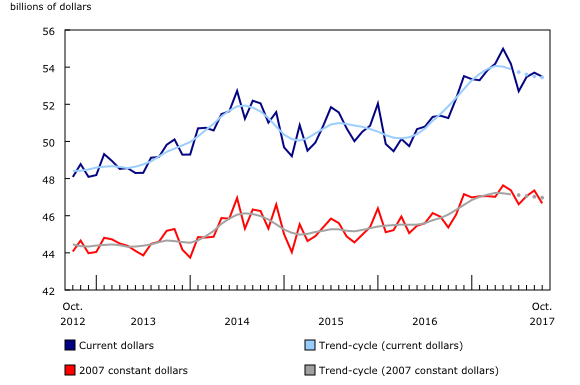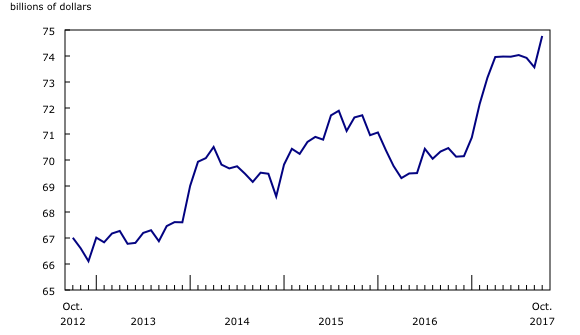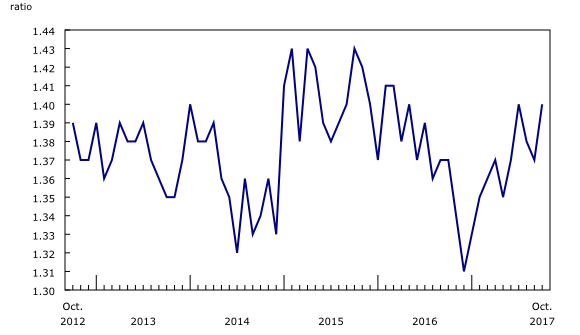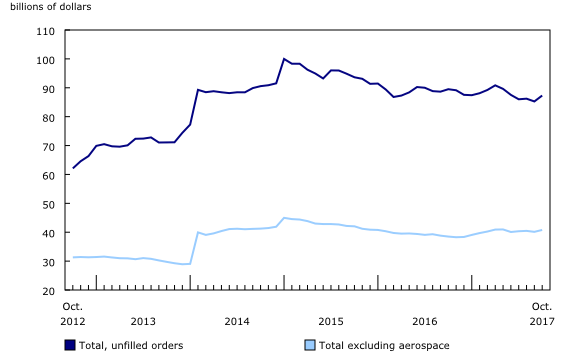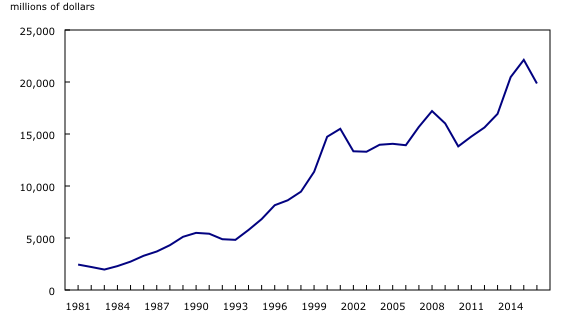Monthly Survey of Manufacturing, October 2017
Archived Content
Information identified as archived is provided for reference, research or recordkeeping purposes. It is not subject to the Government of Canada Web Standards and has not been altered or updated since it was archived. Please "contact us" to request a format other than those available.
Released: 2017-12-15
Manufacturing sales declined 0.4% to $53.5 billion in October, following two consecutive monthly increases.
Sales fell in 8 of 21 industries, representing 56.0% of the manufacturing sector. Sales of motor vehicles and other transportation equipment accounted for most of the decline in October. Excluding these two industries, manufacturing sales increased 0.5%.
In constant dollars, sales decreased 1.5% in October, reflecting a lower volume of goods sold.
Transportation equipment posts the largest decline
Transportation equipment sales declined 5.0% to $9.7 billion in October, mostly due to lower sales of motor vehicle and other transportation equipment.
Sales in the motor vehicle industry fell 6.7% to $4.6 billion, the second consecutive monthly decrease. The decline partly reflected lower volumes generated by decreased production after shutdowns of some assembly plants in October. In constant dollars, sales volumes in the motor vehicle industry fell 7.6%.
Other transportation equipment sales were down 37.2% to $248 million in October. Sales in this industry are volatile compared with sales in the transportation equipment industry as a whole. In constant dollars, sales volume fell 37.9%.
Sales were also down in the chemical (-1.1%) and machinery (-1.4%) industries in October. The declines were widespread and reflected lower volumes of goods sold.
Lower sales in current dollars were partially offset by increases in petroleum and coal (+2.2%) and wood product (+3.4%) industries. After removing the effect of price changes, the volume of sales rose 1.1% and 1.9% respectively in these industries.
Sales down in Ontario
Sales decreased in six provinces in October, led by Ontario.
Sales in Ontario fell 2.2% to $24.0 billion, mainly attributable to declines in the motor vehicle (-7.7%), machinery (-3.6%) and food (-1.4%) industries.
Following three consecutive monthly increases, sales in Quebec declined 0.4% to $13.2 billion, mainly due to the petroleum and coal product and transportation equipment industries. These declines were partly offset by higher sales in the wood product and furniture and related product industries.
In Alberta, sales rose 4.2% to $6.0 billion, following a 1.4% decline in September. Sales were up in 10 of 21 industries, largely driven by higher sales in the petroleum and coal product (+14.7%) and, to a lesser extent, food and fabricated metal product industries.
In British Columbia, sales rose 2.1% to $4.3 billion in October, the third straight monthly increase. Gains were observed in 17 of 21 industries, mainly driven by a 7.0% sales increase in the primary metals industry. Sales were also higher in the paper, wood product and petroleum and coal product industries.
Inventory levels rise
Inventory levels increased 1.6% to $74.8 billion in October, following two consecutive monthly declines. Inventories rose in 16 of 21 industries, with the largest gains in the transportation equipment (+2.8%), primary metals (+2.9%) and machinery (+2.1%) industries.
The inventory-to-sales ratio increased from 1.37 in September to 1.40 in October. The inventory-to-sales ratio measures the time, in months, that would be required to exhaust inventories if sales were to remain at their current level.
Unfilled orders increase
Unfilled orders rose 2.4% in October to $87.3 billion, following a 1.1% decline in September. The growth in October was mainly attributable to more unfilled orders in the aerospace product and parts industry (+3.1%), which was partially due to the depreciation of the Canadian dollar relative to the US dollar during the month.
Unfilled orders also increased in the fabricated metal products, primary metals and machinery industries.
New orders rose 5.3% in October to $55.5 billion, as the aerospace product and parts, primary metals and fabricated metal products industries saw an increase in new orders. This advance was partially offset by a decrease in new orders in the motor vehicle industry.

In celebration of the country's 150th birthday, Statistics Canada is presenting snapshots from our rich statistical history.
The Canadian aerospace industry
The Canadian aerospace industry has become a major component of Canada's economy and accounts for a large part of trade with foreign markets. It all began in 1909 in Baddeck, Nova Scotia, when Douglas McCurdy took flight in the first Canadian mechanical aircraft named the Silver Dart. This came after many experiments by a team led by Alexander Graham Bell. Following more successful flights and the demand from commercial and military markets, foreign companies expanded their manufacturing into Canada. The manufacturers were small compared with those of today but each had specific products that served their customer base. Employment in the late 1930s was about 4,000 workers.
Following the Second World War, these companies became larger and other establishments began operating in the Canadian market. In 1945, at the request of the Royal Canadian Air Force, Avro Canada developed the country's first fighter jet named the CF-100 Canuck. This was to be succeeded by the Avro Arrow, which was designed to intercept long-range bombers carrying nuclear weapons. However, by 1959 the government cancelled the program out of concern that the plane was too expensive and was growing irrelevant.
The aerospace sector has become more diverse over the years. Maintenance, overhaul and repair is being done in many parts of the country. Canada is now home to the production of, but not limited to flight simulators, helicopters, engines and other sophisticated components that feed into the modern aircraft. Canada is also one of the few countries in the world that produces commercial airplanes.
Over the last 30 years, the share of aerospace to total manufacturing sales has risen from about 1.0% to almost 4.0%. In 2016, the aerospace manufacturing industry employed over 45,000 Canadians and generated approximately $20 billion in sales.
Note to readers
Monthly data in this release are seasonally adjusted and are expressed in current dollars unless otherwise specified.
For information on seasonal adjustment, see Seasonally adjusted data – Frequently asked questions. For information on trend-cycle data, see Trend-cycle estimates – Frequently asked questions.
Non-durable goods industries include food, beverage and tobacco products, textile mills, textile product mills, clothing, leather and allied products, paper, printing and related support activities, petroleum and coal products, chemicals, and plastics and rubber products.
Durable goods industries include wood products, non-metallic mineral products, primary metals, fabricated metal products, machinery, computer and electronic products, electrical equipment, appliances and components, transportation equipment, furniture and related products, and miscellaneous manufacturing.
Production-based industries
For the aerospace and shipbuilding industries, the value of production is used instead of the value of sales of goods manufactured. The value of production is calculated by adjusting monthly sales of goods manufactured by the monthly change in inventories of goods in process and finished products manufactured. The value of production is used because of the extended period of time that it normally takes to manufacture products in these industries.
Unfilled orders are a stock of orders that will contribute to future sales, assuming that the orders are not cancelled.
New orders are those received, whether sold in the current month or not. New orders are measured as the sum of sales for the current month plus the change in unfilled orders from the previous month to the current month.
Manufacturers reporting in US dollars
Some Canadian manufacturers report sales, inventories and unfilled orders in US dollars. These data are then converted to Canadian dollars as part of the data production cycle.
For sales, based on the assumption that they occur throughout the month, the average monthly exchange rate for the reference month (noon spot rate) established by the Bank of Canada is used for the conversion. The monthly average exchange rate is available in CANSIM table 176-0081. Inventories and unfilled orders are reported at the end of the reference period. For most respondents, the noon spot exchange rate on the last working day of the month is used for the conversion of these variables.
However, some manufacturers choose to report their data as of a day other than the last day of the month. In these instances, the noon spot exchange rate on the day selected by the respondent is used. Note that because of exchange rate fluctuations, the noon spot exchange rate on the day selected by the respondent can differ from both the exchange rate on the last working day of the month and the monthly average exchange rate. Noon spot exchange rate data are available in CANSIM table 176-0080.
Revision policy
Each month, the Monthly Survey of Manufacturing releases preliminary data for the reference month and revised data for the three previous months. Revisions are made to reflect new information provided by respondents and updates to administrative data.
Real-time CANSIM tables
Real-time CANSIM tables 304-8014, 304-8015 and 377-8009 will be updated on January 3, 2018. For more information, consult the document Real-time CANSIM tables.
Next release
Data from the Monthly Survey of Manufacturing for November 2017 will be released on January 19, 2018.
Contact information
For more information, contact us (toll-free 1-800-263-1136; 514-283-8300; STATCAN.infostats-infostats.STATCAN@canada.ca) or Media Relations (613-951-4636; STATCAN.mediahotline-ligneinfomedias.STATCAN@canada.ca).
For more information, or to enquire about the concepts, methods or data quality of this release, contact Bechir Oueriemmi (613-951-7938; bechir.oueriemmi@canada.ca) or Michael Schimpf (613-863-4480; michael.schimpf@canada.ca), Manufacturing and Wholesale Trade Division.
- Date modified:




